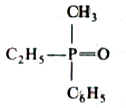Which of the following is a chiral molecule?
1-chloro propane
2-chloro propane
1-chloro butane
2-chloro butane
The correct Answer is:D
To determine which of the given molecules is chiral, we need to identify if any of the molecules contain a chiral carbon atom. A chiral carbon atom is one that is bonded to four different groups or atoms.
1. Understand the Definition of Chirality:
- A molecule is chiral if it has a carbon atom (chiral center) bonded to four different substituents.
2. Analyze the First Option: 1-Chloropropane:
- Structure: CH3-CH2-CH2Cl
- The first carbon (C1) has two hydrogen atoms and one chlorine atom, making it not chiral.
- The second carbon (C2) and third carbon (C3) also do not have four different groups.
- Conclusion: Not chiral.
3. Analyze the Second Option: 2-Chloropropane:
- Structure: CH3-CH(Cl)-CH3
- The second carbon (C2) is bonded to two methyl groups (CH3), one chlorine (Cl), and one hydrogen (H).
- Since C2 has two identical groups (methyl groups), it is not chiral.
- Conclusion: Not chiral.
4. Analyze the Third Option: 1-Chlorobutane:
- Structure: CH3-CH2-CH2-CH2Cl
- The first carbon (C1) has two hydrogen atoms and one chlorine atom, making it not chiral.
- The other carbons also do not have four different groups.
- Conclusion: Not chiral.
5. Analyze the Fourth Option: 2-Chlorobutane:
- Structure: CH3-CH(Cl)-CH2-CH3
- The second carbon (C2) is bonded to:
- One chlorine (Cl)
- One hydrogen (H)
- One methyl group (CH3)
- One ethyl group (CH2-CH3)
- Since all four substituents on C2 are different, this carbon is a chiral center.
- Conclusion: This molecule is chiral.
6. Final Answer:
- The chiral molecule among the options is 2-Chlorobutane.
- A molecule is chiral if it has a carbon atom (chiral center) bonded to four different substituents.
- Structure: CH3-CH2-CH2Cl
- The first carbon (C1) has two hydrogen atoms and one chlorine atom, making it not chiral.
- The second carbon (C2) and third carbon (C3) also do not have four different groups.
- Conclusion: Not chiral.
- Structure: CH3-CH(Cl)-CH3
- The second carbon (C2) is bonded to two methyl groups (CH3), one chlorine (Cl), and one hydrogen (H).
- Since C2 has two identical groups (methyl groups), it is not chiral.
- Conclusion: Not chiral.
- Structure: CH3-CH2-CH2-CH2Cl
- The first carbon (C1) has two hydrogen atoms and one chlorine atom, making it not chiral.
- The other carbons also do not have four different groups.
- Conclusion: Not chiral.
- Structure: CH3-CH(Cl)-CH2-CH3
- The second carbon (C2) is bonded to:
- One chlorine (Cl)
- One hydrogen (H)
- One methyl group (CH3)
- One ethyl group (CH2-CH3)
- Since all four substituents on C2 are different, this carbon is a chiral center.
- Conclusion: This molecule is chiral.
- The chiral molecule among the options is 2-Chlorobutane.
Similar Questions
Knowledge Check
Which of the following is chiral?
ACell phoneBSpiral staircaseCScissorDAll of theseWhich of the following is chiral?
A B
B C
C D
D
Which of the following is not chiral?
View SolutionWhich of the following is a chiral compound?
View SolutionWhich of the following is/are chiral?
View SolutionWhich of the following is a polar molecule ?
View SolutionWhich of the following is a polar molecule
View SolutionWhich of the following is a polar molecule
View Solution


